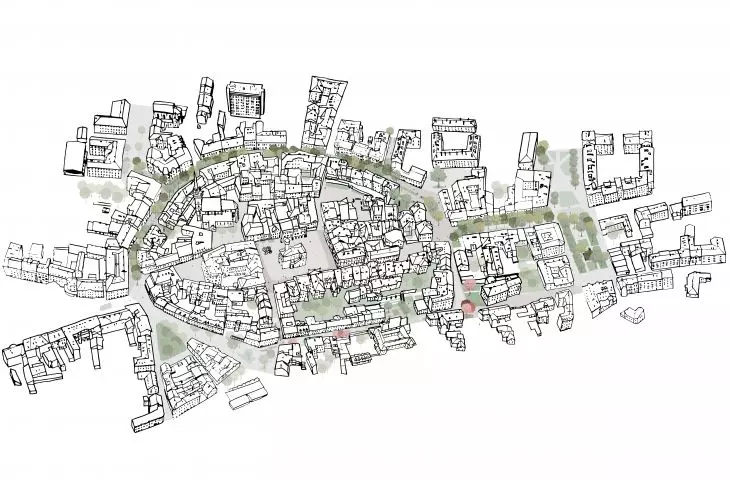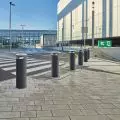Designed by the JAZ+ Architects studio, the concept for the redevelopment of Walnut Street has attracted mixed reviews. What did the design process look like? What was most important in making the changes? We talk about the ideas behind the changes with Andrzej Jaworski and Anna Kotowska of JAZ+ Architects.
We wrote about the concept for the reconstruction of Wałowa Street in Tarnów on the portal(See here).
Wiktor Bochenek: After the project was published by several popular regional portals, I reviewed the comments. The two most important objections are the classic lack of parking spaces and too much interference with the historic part of the city - how do you comment on this?
Andrzej Jaworski, Anna Kotowska: Walowa Street is already a pedestrian promenade with no designated parking spaces, in the project we proposed additional temporary spaces for deliveries and spaces for people with limited mobility. We have also proposed several new city bike stations and a new bicycle route separated from pedestrian traffic. The number of parking spaces, for possible deliveries, is a total of seven on Walnut Street alone, including one for a person with limited mobility, and in the second variant is four spaces.
The number of legal parking spaces on the streets: Kupiecka, Dąbrowskiego and Drzewna increased by a total of nine spaces. Only on Szeroka and Bernardinskaya Streets was their total number reduced, as a result of the introduction of a new bicycle route there. The total number of parking spaces decreased in the concept area by about 11%. (127 existing to 113 or 110 design ones - depending on the option adopted).
We, personally, are pleased by the openness of the city authorities seeking solutions adequate to the ongoing climate change, which, however, involve other priorities regarding the organization of transportation in the city. Such changes also result in a reduction in the supply of parking spaces, which may, of course, raise objections, but in this case is necessary if we want to improve the principles of water management, increase the share of greenery and create conditions for ecological mobility in the city center
To answer the second question, one of the main design goals was to increase the attractiveness and accessibility of the city's historic spaces. Design decisions were based on the materials presented, consultations with the Provincial Office for Historic Preservation - Tarnow delegation, and a thorough analysis of archival materials. The proposed changes were also given a positive opinion by the WUOZ. Among other things, the project plans to replace the current red concrete pavement with stone pavement and standardize it along the entire length of the street. The plans also include restoring the former streetcar rails on a section of Walnut Street, as a visible sign of the site's history. The greenery project envisages highlighting important axes and routes, while not obscuring important historical objects and view openings.
The most noticeable change throughout the study area will be the introduction of greenery in the form of new plantings of trees, shrubs and wide expanses of low greenery. Walowa Street is to gain tall greenery - in some places two, alternating rows of trees. It is also worth recalling the post-war, unrealized but nevertheless contemplated plans for a comprehensive transformation of Walnut Street into a plantation, which we discovered while reviewing archival materials at the conservationist's office. It can be said that our project in a sense refers to the idea of a green ring along the former city fortifications.
The project also includes the revaluation of Grand Staircase Street. The mascaron, located within its area, requires special exposure through appropriate lighting and calming its surroundings, such as: removing antennas, removing or replacing flashy advertising banners and changing traffic organization solutions on Bernardyńska Street at the foot of the stairs, where there is currently an asymmetrically designed pedestrian crossing. The project also envisages exposing the monastery gate on Bernardyńska Street and emphasizing the historical character of this area, the site of the monastery's former gardens and orchards, by proposing to locate plantings of flowering fruit trees along this street.
The concept concerns not only Walowa Street, but the entire surroundings around the center
© JAZ+ Architects
Wiktor Bochenek: Where did you start preparing to create the concept?
Andrzej Jaworski, Anna Kotowska:At the very beginning, we met with city officials from Tarnów and representatives of WUKZ. Those responsible for communications, greenery, monuments showed us around the entire study area, pointing out needs and answering questions. In the next step, we diagnosed ourselves what are the current spatial and functional solutions in these streets and what, in our opinion, is missing there, during this diagnosis we also took temperature measurements of selected surfaces, such as the city benches of Walowa Street.
The greening is supposed to help improve microclimate and retention
© JAZ+ Architects
Wiktor Bochenek: What is the most important thing about this urban planning concept?
Andrzej Jaworski, Anna Kotowska: The main objective of the change is to adapt the city to climate change. Tarnów is called the "Polish Pole of Warmth" not without reason, so climate change is even more noticeable. The second major goal was to increase accessibility for diverse audiences, including the blind, wheelchair users and the elderly, which was reflected in appropriate flooring solutions and the adaptation of Katyn Victims Square for wheelchair use and convenient entry/exit with a baby carriage. All these solutions we tried to inscribe in the historic character of the space while highlighting characteristic places and valuable views or openings, as we also prioritized the authentication of elements of the existing urban composition. Another goal to be achieved through the project is to improve the functionality and flexibility of public spaces, i.e. to adapt the solutions to different groups of users: residents, commercial tenants and tourists, and to the ever-changing "scenarios" of the operation of these spaces. We are talking both about adapting the space for various special events, adapting it for service functions and simply a place of intense community - urban life.
In many places, the new plantings are to be a subtle addition
© JAZ+ Architects
Wiktor Bochenek : How is the blue-green infrastructure to be improved - how will it affect this part of the city.
Andrzej Jaworski, Anna Kotowska: The project contains only general guidelines and recommendations prepared by an experienced hydrologist and should be developed in detail at further stages, so that they work in a comprehensive system of rainwater management in the city, no less some of the solutions can be applied locally.
In the axis of Walnut Street, we designed an open channel of water runoff, which connects a network of green areas and rain gardens. On other streets- single rain gardens, and a water cascade in Grand Staircase Street. Increasing the proportion of water will also require an appropriate selection of plant species - which is also included in the concept.
Increasing the biologically active area, is intended to lower the ambient temperature, increase transpiration of water vapor and thus improve the microclimate. The runoff of water directly into the ground and rain gardens will also reduce flooding occurring in the area and improve the operation of city services for irrigating plants. For example, concrete pots are currently set up on the main street, which require intensive watering during hot weather.
We hope that the changes introduced will improve the comfort of residents walking along these streets, and become a model for other cities.
Consideration of hydrology was important in designing the concept
© JAZ+ Architects
Wiktor Bochenek: How will the small architecture and lighting be unified?
Andrzej Jaworski, Anna Kotowska: We tried to start from existing and already well-functioning solutions, proposing only minor changes. On this basis, general guidelines consistent with conservation recommendations were created.
Currently, the study area, we feel, is even overloaded with various elements that do not necessarily fit together.
That's why the project included recommendations that all streetlights, poles, bulletin pole finials, bicycle racks, information boards and other hardware should be of one color, consistent with the historic elements, i.e. black or dark anthracite. Benches, on the other hand, would be made of natural materials, with a high proportion of wood.
The surface of Walowa Street would also be unified, continuing the material of neighboring Krakowska Street, as well as Bernardinska Street, where the granite slab sidewalk already used on a section of it would be applied.
We propose to use lighting to better articulate the monuments. Improving the safety and comfort of currently underexposed areas was also an important consideration in the project.
Some of the space needed to be democratized, greened while respecting the function of the
© JAZ+ Architects
Wiktor Bochenek: What else will change in the space of the Square of Katyn Victims besides improving communication and democratization?
Andrzej Jaworski, Anna Kotowska: The project assumes that the ratio of biologically active space to paved space in this location fromhas shimmered compared to the existing state. This difference is significant. However, the introduction of more greenery will not affect the possibility of organizing ceremonies in this square while maintaining its functionally important role in the city. Also important is the proposal for people with mobility limitations, e.g.: people with disabilities or parents with children in strollers. We propose using a properly sloped sidewalk blended into the terraced staircase instead of a ramp with a steeper incline with handrails. In this way, this space will not become aesthetically caricatured and non-functional. This may not be a perfect solution, but in our opinion it is acceptable and significantly improves the accessibility of this space for various users.
Terraced solution introduced at the Square of Katyn Victims
© JAZ+ Architects
Wiktor Bochenek: What was most important in fitting greenery in this space. Why did you decide on these particular solutions?
Andrzej Jaworski, Anna Kotowska: This is only a concept, which can be supplemented and corrected in further steps, but it indicates certain principles of shaping greenery, especially trees, in appropriate urban spaces. We consulted the solutions with the delegation of the Provincial Office for Historic Preservation in Tarnów in terms of the selection of appropriate species for functional needs, historical references and adequate for given locations for compositional reasons.
It was also important whether these given species are suitable for use in urban conditions. We are constantly observing these issues in Warsaw, not only in our projects, by the way. On Wałowa Street itself, we mainly took into account the transparency of the tree crowns - and in the project we proposed those that will provide access of light to residential units. That's why we chose there, among others, field maples of the Elsrijk variety with transparent crowns, but also ash trees. On Bernardyńska Street, due to historical associations, we decided to introduce fruit trees, and in this case the choice fell on the ball cherry. The selection of specific plant species was as important to us as infrastructure or transportation issues.
Wiktor Bochenek: Thank you for the interview!
The concept focuses primarily on the problems of modernity
© JAZ+ Architects

















































